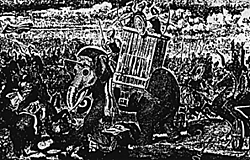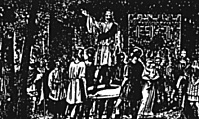
The Ottomans of the Sultan continued their relentless advance against the Muslim Indians in the mid 14th century. Following a smashing defeat in the first DBM encounter, the Indians regrouped a month later to once again try to stop the mounted onslaught.
 The Indians formed on the banks of the Sacred River for this second action, deploying outward
with the river on their left. A mixed group of (inferior) bowmen and (superior/expensive)
elephants backed by a column of (superior) Jagir cavalry formed the left wing. A small hill in the center of the field was occupied by five stands of Jagirs in ambush; to their right/rear was a mixed command of swordsmen (fast blades) and more elephants. A handful of light troops covered the right side woods. Four stands of fearless Rathors (fast knights) were hidden behind the woods.
The Indians formed on the banks of the Sacred River for this second action, deploying outward
with the river on their left. A mixed group of (inferior) bowmen and (superior/expensive)
elephants backed by a column of (superior) Jagir cavalry formed the left wing. A small hill in the center of the field was occupied by five stands of Jagirs in ambush; to their right/rear was a mixed command of swordsmen (fast blades) and more elephants. A handful of light troops covered the right side woods. Four stands of fearless Rathors (fast knights) were hidden behind the woods.
The invading Ottomans had not yet developed the famous janissaries. They were formed in two mostly mounted commands of equal size. Closest to the river was a long line of superior light horse fronted by a mixed line of auxilia and superior psiloi. Another small group of light horse was in reserve to their rear, in column.
The main strike force occupied the center, roughly opposite the hill. T his double line of sipahis had superior troops in front, supported by ordinary cavalry. To their left, a woods in the deployment area posed some difficulties. Psiloi were deployed to both sides, in case of ambush, and another double column of light horse covered the far left.
The center hill became the objective of both sides, but the battle would not be decided there. The Ottoman sipahis made directly for the hill- but very slowly (1). The Indians responded by swinging the Rathors (even more slowly) behind the swordsmen to form to the right of the hill. Next to the river, the Ottoman light infantry rushed forward (2) to engage the bow/elephants and isolate the hill. The Indians intended to win the battle here with the combined bow/elephants and superior Jagirs. However they demonstrated no initiative, to the frustration of the CinC, and were completely bottled up by the lights.
On the other side of the field, the Ottoman psiloi cleared the empty woods of potential trouble while the light horse slowly formed a line in front of the woods. The opposing swordsmen/elephants sideslipped to their right and advanced in good order (3).
Meanwhile at the center hill, the sipahis charged before the Rathors arrived. The Indians were pushed back but not severely hurt. They still held the crest. The Rathors eventually showed up but fought poorly (i.e. rolled bad) and a stalemate developed with no losses on either side. On the Indians right, the swordsmen/elephants surged past the hillside stalemate and broke through the light horse, many of which fled rather then die. The impetuous fast blades left the plodding elephants behind and cut into the psiloi who had cleared the woods.
The battle was to be finished however next to the river. The Ottoman light foot ignored the futile arrows of the Indians and charged home against the left end of the Indian line. The right hand Indian elements continued to the relief of the hill (4) and eventually flanked the light horse to their left. The inferior bowmen died in droves before the Ottoman attack, however, the elephants finally held the position. The casualty exchange was brutal on the very small Indian army. While the elephants maneuvered to stay alive, their supporting cavalry watched (no PIPs). They eventually moved next to the Aver and fruitlessly engaged the line of light horse who had done the same.
Both sides simultaneously bled to death: the Indian bowmen were mostly gone but the elephants had destroyed a lot of light troops, with mounted and foot Also, two of the four Rathors died together near the hill-- fast troops can be so fragile. It was a bloody draw. The after action report follows.
1. The Ottoman light foot attack into the bows/elephants was brilliant. They eventually died but they killed a lot of bowmen, kept the elephants off of the horsemen (for a while) and isolated the hill. Conversely, standing to receive by the Indians was a tactical mistake since it let the Ottomans roll the psiloi:bow matchups before the psiloi:elephants.
2. Charging uphill rarely works. Even though the target was isolated, the Ottoman attack failed. If the Rathors had fought better, it could have been an Ottoman catastrophe.
3. The success of the swordsmen/elephants on the Indian right had little impact, most of the Ottomans merely fled at no cost to the Sultan's main efforts. It was interesting that the elephants were left behind by the impetuous swordsmen following the initial impact. I would like to see the elephants be impetuous too.
4. Finally, I think two commands are too few for the irregular Ottomans. A third general only costs ten points and generates a 50% increase in PIPs. The Ottoman reserve never moved. No doubt, smaller commands are more brittle. The Indians three commands may have been too many given the very high cost per stand of the superior elephants and cavalry.
 In any case, it was fun, and while nobody like a tie--that is the best the Indians have managed in four tries. It must be time to try again!
In any case, it was fun, and while nobody like a tie--that is the best the Indians have managed in four tries. It must be time to try again!
Back to Saga #54 Table of Contents
© Copyright 1996 by Terry Gore
This article appears in MagWeb (Magazine Web), available on the Internet World Wide Web at http://www.magweb.com
